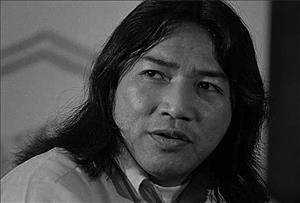Native American leader Bernie Whitebear guided the United Indians of All Tribes Foundation, which provided social services to Native Americans. He ran the foundation for 30 years. He was famous for leading the symbolic 1970 Indian invasion of Fort Lawton at Discovery Park in Seattle. As a result of the invasion and despite the Army's attempt to eject the protestors, Daybreak Star Center was eventually established in the park.
Green Beret
Whitebear was born Bernie Reyes in Inchelium in Eastern Washington on September 27, 1937, one of six children of an Indian mother and Filipino father. He was descended from members of the Sin-Aikst Tribe, later known as Lakes Indians, now part of the Colville Confederated Tribe. He was raised on the Colville Indian Reservation, where his father worked odd jobs. After graduating from high school in Okanogan, Whitebear joined the Army, where in the late 1950s he served with the 101st Airborne Division and became a Green Beret.
After experiencing prejudice while in the Army, the young Whitebear changed his name from Reyes to honor his grandfather and dedicated himself to helping Native Americans all over the country. Leaving the Army, he joined activist Bob Satiacum in his drive for Indian fishing rights on Northwest rivers. After many years of court battles, Judge George Boldt handed down an historic ruling on February 12, 1974, allocating 50 percent of the catch to the tribes.
Activist
In the meantime, Whitebear had become active in a number of Indian causes. On March 8, 1970, he was among the leaders and instigators of about 100 Native Americans and sympathizers who confronted the 392nd Military Police Company, armed with riot gear, at Fort Lawton. The protesters were trying to claim, as part of their historic lands, a part of 1,100-acre military reservation, which was being declared surplus by the Army. After a brief scuffle, the military police took the Indians and sympathizers into custody and ejected them from the park.
The incident was not over, however, and the Native American encampment outside the fort, as well as the involvement of celebrities such as Jane Fonda, became a constant reminder of the Indian claims. After long negotiations and Congressional intervention, the protest ultimately (in 1977) resulted in a solution permitting development of Daybreak Star Center by United Indians of All Tribes and directed by Whitebear. It also resulted in a municipal Discovery Park, now Seattle's single largest recreational tract.
Decades of Service
Whitebear ran the United Indians of All Tribes Foundation for nearly 30 years. Until the end, he fought for construction of the People's Lodge, a cultural and educational institution that he envisioned as an unprecedented resource for his people. Despite resistance from residents of the Magnolia neighborhood near Discovery Park, his supporters continue to pursue the siting of the new facility.
On July 16, 2000, Whitebear died of colon cancer at his home without seeing his dream of a 123,000-square-foot People's Lodge built in Discovery Park. But the dream lives on with his supporters and so does Whitebear's memory. In the end, supporters and opponents alike memorialized Whitebear as a man of character and courage, and a leader willing to work with other ethnic groups and to help them understand the Native American heritage and culture.

